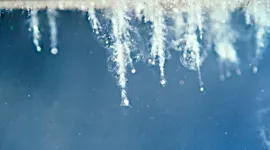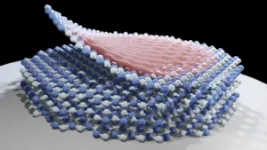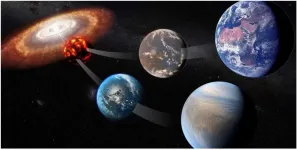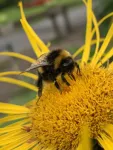(Press-News.org)
Following enormous collisions, such as asteroid impacts, some amount of material from an impacted world may be ejected into space. This material can travel vast distances and for extremely long periods of time. In theory this material could contain direct or indirect signs of life from the host world, such as fossils of microorganisms. And this material could be detectable by humans in the near future, or even now.
When you hear the words vacuum and dust in a sentence, you may groan at the thought of having to do the housework. But in astronomy, these words have different connotations. Vacuum of course refers to the void of space. Dust, however, means diffuse solid material floating through space. It can be an annoyance to some astronomers as it may hinder their views of some distant object. Or dust could be a useful tool to help other astronomers learn about something distant without having to leave the safety of our own planet. Professor Tomonori Totani from the University of Tokyo’s Department of Astronomy has an idea for space dust that might sound like science fiction but actually warrants serious consideration.
“I propose we study well-preserved grains ejected from other worlds for potential signs of life,” said Totani. “The search for life outside our solar system typically means a search for signs of communication, which would indicate intelligent life but precludes any pre-technological life. Or the search is for atmospheric signatures that might hint at life, but without direct confirmation there could always be an explanation that does not require life. However, if there are signs of life in dust grains, not only could we be certain, but we could also find out soon.”
The basic idea is that large asteroid strikes can eject ground material into space. There is a chance that recently deceased or even fossilized microorganisms could be contained in some rocky material in this ejecta. This material will vary in size greatly, with different-sized pieces behaving differently once in space. Some larger pieces might fall back down or enter permanent orbits around a local planet or star. And some much smaller pieces might be too small to contain any verifiable signs of life. But grains in the region of 1 micrometer (one-thousandth of a millimeter) could not only host a specimen of a single-celled organism, but they could also potentially escape their host solar system altogether, and under the right circumstances, maybe even venture to ours.
“My paper explores this idea using available data on the different aspects of this scenario,” said Totani. “The distances and times involved can be vast, and both reduce the chance any ejecta containing life signs from another world could even reach us. Add to that the number of phenomena in space that can destroy small objects due to heat or radiation, and the chances get even lower. Despite that, I calculate around 100,000 such grains could be landing on Earth every year. Given there are many unknowns involved, this estimate could be too high or too low, but the means to explore it already exist so it seems like a worthwhile pursuit.”
There may be such grains already on Earth, and in plentiful amounts, preserved in places such as the Antarctic ice, or under the seafloor. Space dust in these places could be retrieved relatively easily, but discerning extrasolar material from material originating in our own solar system is still a complex matter. If the search is extended to space itself, however, there are already missions that capture dust in the vacuum using ultralight materials called aerogels.
“I hope that researchers in different fields are interested in this idea and start to examine the feasibility of this new search for extrasolar life in more detail.” said Totani.
###
Journal article: Tomonori Totani. “Solid grains ejected from terrestrial exoplanets as a probe of the abundance of life in the Milky Way”, International Journal of Astrobiology.
DOI: 10.48550/arXiv.2210.07084
Funding:
KAKENHI (grant from MEXT) No. 18K03692.
Useful links:
Graduate School of Science - https://www.s.u-tokyo.ac.jp/en/
Department of Astronomy - http://www.astron.s.u-tokyo.ac.jp/en/
Institute of Astronomy - http://www.ioa.s.u-tokyo.ac.jp/en/
Research contact:
Professor Tomonori Totani
Department of Astronomy, The University of Tokyo,
7-3-1 Hongo, Bunkyo-ku, Tokyo, 113-0033, Japan
totani@astron.s.u-tokyo.ac.jp
Press contact:
Mr. Rohan Mehra
Public Relations Group, The University of Tokyo,
7-3-1 Hongo, Bunkyo-ku, Tokyo, 113-8656, Japan
press-releases.adm@gs.mail.u-tokyo.ac.jp
About The University of Tokyo
The University of Tokyo is Japan's leading university and one of the world's top research universities. The vast research output of some 6,000 researchers is published in the world's top journals across the arts and sciences. Our vibrant student body of around 15,000 undergraduate and 15,000 graduate students includes over 4,000 international students. Find out more at www.u-tokyo.ac.jp/en/ or follow us on Twitter at @UTokyo_News_en.
END
With the first paper compiling all known information about planets like Venus beyond our solar system, scientists are the closest they’ve ever been to finding an analog of Earth’s “twin.”
If they succeed in locating one, it could reveal valuable insights into Earth’s future, and our risk of developing a runaway greenhouse climate as Venus did.
Scientists who wrote the paper began with more than 300 known terrestrial planets orbiting other stars, called exoplanets. They whittled the list down to the five most likely to ...
New scientific research investigates inflammation and insulin resistance in habitual coffee drinkers to understand how coffee may reduce the risk of type 2 diabetes (T2D), mediated by inflammatory biomarkers in the body 1.
Drinking just one additional cup of coffee per day was associated with a 4-6% lower risk of T2D among participants in two large prospective cohort studies, which was partly explained by lower levels of inflammation1.
Experts consider consuming up to 400mg of caffeine (3-5 cups of coffee) per day to be a moderate and safe amount for most adults. For pregnant or lactating women, caffeine intake should be reduced to 200mg per day2.
These results further support previous ...
Working for a big company or in an HR role does not lower the likelihood of showing unconscious bias against disabled people at work, a new study finds.
Researchers say this is ‘surprising’ because of the money many large firms spend on EDI and unconscious bias training – in 2017 up to $8bn in the US alone – and the fact HR professionals are often specifically trained in EDI issues.
The research, a collaboration between the University of Exeter’s Business School and Medical ...
In a study of Danish children born between 1978–2000, chances of graduating from lower and upper secondary education were significantly lower for children born by cesarean section (CS). However, differences in grade point averages and intelligence scores were very small. The study, which is published in Acta Obstetricia et Gynecologica Scandinavica, also found that males born by CS had a lower likelihood of appearing before a conscription board for drafting into the military.
In Denmark, most students are 6–16 years old while in lower secondary education (LSE) and 16–17 years old when initiating ...
Results from a clinical trial published in the Journal of Internal Medicine reveal several health benefits of moderate salt restriction in patients on standard medical treatment for primary aldosteronism.
Primary aldosteronism—a condition in which the adrenal glands make too much of the hormone aldosterone—is a common cause of secondary hypertension. The combination of aldosterone excess and high dietary salt intake leaves affected patients with a higher risk of cardiovascular disease than patients with hypertension ...
Seals, sea lions, and fur seals are at risk from interactions with fisheries and aquaculture, as they can become entangled in nets or cages, and drown. In a study published in Mammal Review, investigators analyzed research from the last 25 years on operational and biological interactions between these marine mammals and fisheries and aquaculture activities in South American waters.
The authors found that two species are primarily involved in interactions in many countries: the South American sea lion Otaria flavescens and the South American fur seal Arctocephalus australis. ...
In an analysis of perinatal care provided in the United States, investigators found few differences by race for care that was based on guidelines or expert recommendations; however, discretionary care (for which professional recommendations or guidelines do not exist) varied by race.
The analysis, which is published in Birth, included information from the electronic health records for 7,056 women who delivered infants within a large hospital system between 2012 and 2018. Compared with Non-Hispanic white women, Non-Hispanic Black women were ...
New research published in Human Brain Mapping reveals sex differences and developmental changes in the brain’s white matter—which provides communication between different parts of the brain—in healthy, typically developing infants and 5-year-olds.
The results, which highlighted sexual dimorphism in brain structure during development with significant detectable differences in multiple regions at the age of 5 years, agree with prior studies showing earlier brain development in females.
Also, changes in white matter asymmetry patterns occurred during early childhood, and in 5-year-olds the pattern already resembled adult-like patterns.
“We observed sex differences ...
Dysregulation of microRNAs, which are molecules involved in controlling gene expression, can promote tumor formation and progression. A study in The FASEB Journal found that the miR-145 microRNA can suppress the growth of cervical cancer cells.
miR-145 was expressed at lower than normal levels in human cervical cancer cells, and lower levels correlated with more advanced clinical stages of cervical cancer in patients.
Experiments in cells and mice revealed the mechanisms behind miR-145 effects and pointed to potential targets that could be ...
Temperature influences how badly pesticides affect bees’ behaviour, suggesting uncertain impacts under climate change, according to a new study.
The findings indicate that future extreme temperature events under climate change could increase the impact of pesticides on bee populations and their pollination services.
Certain pesticides, particularly a class called neonicotinoids, are known to impact bees and other important insects, and are thought to be contributing to population declines. However, bees’ reported responses to this threat across the world often seem to vary, suggesting other interacting factors ...




